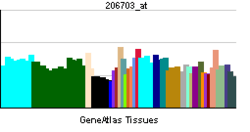CHRNB1
Acetylcholine receptor subunit beta is a protein that in humans is encoded by the CHRNB1 gene.[1]
The muscle acetylcholine receptor is composed of five subunits: two alpha subunits and one beta, one gamma, and one delta subunit. This gene encodes the beta subunit of the acetylcholine receptor. The acetylcholine receptor changes conformation upon acetylcholine binding leading to the opening of an ion-conducting channel across the plasma membrane. Mutations in this gene are associated with slow-channel congenital myasthenic syndrome.[1]
See also
References
Further reading
- Kraus H (1977). "Research methods in the biomechanics of sports". Orthop. Clin. North Am. 8 (3): 549–62. PMID 887246.
- Bracci L, Lozzi L, Rustici M, Neri P (1992). "Binding of HIV-1 gp120 to the nicotinic receptor". FEBS Lett. 311 (2): 115–8. doi:10.1016/0014-5793(92)81380-5. PMID 1397297.
- Beeson D, Jeremiah S, West LF et al. (1990). "Assignment of the human nicotinic acetylcholine receptor genes: the alpha and delta subunit genes to chromosome 2 and the beta subunit gene to chromosome 17". Ann. Hum. Genet. 54 (Pt 3): 199–208. doi:10.1111/j.1469-1809.1990.tb00378.x. PMID 2221824.
- Beeson D, Brydson M, Newsom-Davis J (1989). "Nucleotide sequence of human muscle acetylcholine receptor beta-subunit". Nucleic Acids Res. 17 (11): 4391. doi:10.1093/nar/17.11.4391. PMC 317965. PMID 2740233.
- Gomez CM, Maselli R, Gammack J et al. (1996). "A beta-subunit mutation in the acetylcholine receptor channel gate causes severe slow-channel syndrome". Ann. Neurol. 39 (6): 712–23. doi:10.1002/ana.410390607. PMID 8651643.
- Engel AG, Ohno K, Milone M et al. (1997). "New mutations in acetylcholine receptor subunit genes reveal heterogeneity in the slow-channel congenital myasthenic syndrome". Hum. Mol. Genet. 5 (9): 1217–27. doi:10.1093/hmg/5.9.1217. PMID 8872460.
- Quiram PA, Ohno K, Milone M et al. (1999). "Mutation causing congenital myasthenia reveals acetylcholine receptor beta/delta subunit interaction essential for assembly". J. Clin. Invest. 104 (10): 1403–10. doi:10.1172/JCI8179. PMC 409847. PMID 10562302.
- Cousin P, Billotte J, Chaubert P, Shaw P (2000). "Physical map of 17p13 and the genes adjacent to p53". Genomics 63 (1): 60–8. doi:10.1006/geno.1999.6062. PMID 10662545.
- Strausberg RL, Feingold EA, Grouse LH et al. (2003). "Generation and initial analysis of more than 15,000 full-length human and mouse cDNA sequences". Proc. Natl. Acad. Sci. U.S.A. 99 (26): 16899–903. doi:10.1073/pnas.242603899. PMC 139241. PMID 12477932.
- Gerhard DS, Wagner L, Feingold EA et al. (2004). "The status, quality, and expansion of the NIH full-length cDNA project: the Mammalian Gene Collection (MGC)". Genome Res. 14 (10B): 2121–7. doi:10.1101/gr.2596504. PMC 528928. PMID 15489334.
- Sadasivam G, Willmann R, Lin S et al. (2006). "Src-family kinases stabilize the neuromuscular synapse in vivo via protein interactions, phosphorylation, and cytoskeletal linkage of acetylcholine receptors". J. Neurosci. 25 (45): 10479–93. doi:10.1523/JNEUROSCI.2103-05.2005. PMID 16280586.
- Lou XY, Ma JZ, Payne TJ et al. (2007). "Gene-based analysis suggests association of the nicotinic acetylcholine receptor beta1 subunit (CHRNB1) and M1 muscarinic acetylcholine receptor (CHRM1) with vulnerability for nicotine dependence". Hum. Genet. 120 (3): 381–9. doi:10.1007/s00439-006-0229-7. PMID 16874522.
External links
- CHRNB1 protein, human at the US National Library of Medicine Medical Subject Headings (MeSH)
This article incorporates text from the United States National Library of Medicine, which is in the public domain.
| ||||||||||||||||||||||||||||||||||||||||||||||||||||||
